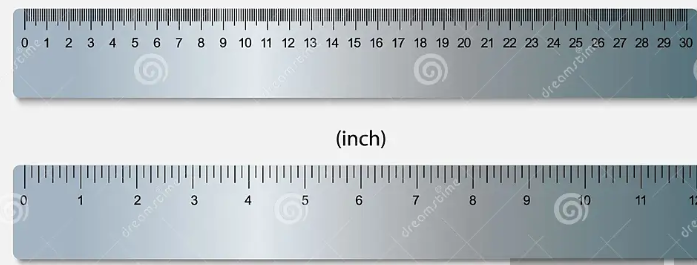Conversions between inches and centimeters are essential in a globally connected world. People frequently encounter different measurement systems, with inches being common in the United States and centimeters in most other countries. Understanding how to quickly convert units, like 10.5 inches to centimeters, simplifies tasks in fields such as design, engineering, education, and everyday projects. In this article, we’ll cover the exact conversion, useful applications, common challenges, and provide solutions to make converting inches to centimeters a breeze.
1. Understanding Inches and Centimeters
Inches are a unit of length primarily used in the United States and other countries that follow the imperial system. Centimeters (cm) belong to the metric system, widely used worldwide. While the U.S. predominantly uses inches, centimeters are standard in Europe, Asia, and beyond. Converting between these units is essential for smooth global interactions.
2. How to Convert 10.5 Inches to Centimeters
To convert 10.5 inches into centimeters, a simple formula applies: multiply inches by 2.54 (since 1 inch equals 2.54 centimeters).
10.5 inches × 2.54 = 26.67 cm
Thus, 10.5 inches is equal to 26.67 centimeters.
3. Formula for Converting Inches to Centimeters
The formula to convert any measurement in inches to centimeters is straightforward:
Length in cm=Length in inches×2.54\text{Length in cm} = \text{Length in inches} \times 2.54
This formula makes conversions easy, whether on paper or in your head. Here’s how it breaks down:
- Multiply your length in inches by 2.54 to get the length in centimeters.
- For example, for 10.5 inches, we simply calculate 10.5×2.54=26.6710.5 \times 2.54 = 26.67.
4. Using a Conversion Table for Quick Reference
A conversion table provides a quick way to find common measurements in inches and their equivalent centimeters without manually calculating each time. Here’s a small sample around 10.5 inches:
| Inches | Centimeters |
|---|---|
| 10.0 | 25.4 |
| 10.5 | 26.67 |
| 11.0 | 27.94 |
| 12.0 | 30.48 |
Such tables are helpful when measurements are needed frequently, and accuracy is crucial.
5. Why It’s Important to Know Unit Conversions
Understanding conversions between inches and centimeters bridges communication gaps, especially in international settings. It also ensures accuracy in scientific research, construction, product design, and more. Inconsistent measurements can lead to errors in manufacturing, logistics, and even digital marketing where screen dimensions must align with local standards.
6. Benefits of Accurate Measurement Conversion
Accurate measurement conversions prevent errors, enhance consistency, and save time. For instance:
- In Manufacturing: Precision avoids material waste.
- In Medicine: Precise conversions ensure correct dosages and medical equipment sizing.
- In Education: Accurate units foster a global understanding, vital in scientific learning.
7. Practical Applications of Converting 10.5 Inches to Centimeters
Knowing the conversion for 10.5 inches to centimeters is useful across diverse fields:
- In Design: Many U.S. product specifications are in inches, yet global manufacturers require metric measurements.
- Home Renovation: Measurements in both inches and centimeters facilitate international material sourcing.
- Shopping Online: Products with global reach often display measurements in multiple units for broader accessibility.
8. Converting Inches to Centimeters in Different Industries
Different industries rely heavily on accurate conversions between inches and centimeters:
- Automotive: Car parts are manufactured worldwide, and many are measured in centimeters or inches.
- Fashion: Clothing manufacturers produce sizes in both imperial and metric units.
- Construction: Builders working on international projects use both measurements for efficiency and accuracy.
9. How Conversions Apply in Home and DIY Projects
In home improvement projects, using both inches and centimeters can help when sourcing materials. For example:
- Furniture Fitting: A shelf’s width measured in inches may need conversion for a metric ruler.
- Picture Framing: Frames often come in standard inch sizes, but wall dimensions might be in centimeters.
- Decorative Arts: International design resources might offer measurements in either metric or imperial units.
10. The Role of Unit Conversion in Education
Teaching unit conversions in classrooms enhances math skills and prepares students for international collaboration. Students learn how to convert from inches to centimeters and vice versa, building foundational math skills and facilitating global scientific literacy.
11. Challenges in Converting Inches to Centimeters
Rounding Issues
Measurements don’t always convert to exact numbers. For example, converting 10.5 inches results in 26.67 centimeters, often rounded to 26.7 cm for practicality. Rounding, however, can lead to slight discrepancies.
Mixed Measurements
Mixing metric and imperial measurements creates confusion. Items might be listed with both units, causing consumers to struggle with consistent measurement.
Learning Curves
Individuals unfamiliar with the metric system might find it difficult to interpret centimeter measurements initially. Familiarity with both systems comes with practice.
12. Solutions for Accurate and Easy Conversions
Use Conversion Calculators
Online calculators offer fast and accurate conversions, avoiding manual errors. Tools like Google’s unit converter or specialized apps help handle complex measurements quickly.
Memorize Key Conversions
For frequent users, memorizing common conversions like 1 inch = 2.54 cm simplifies quick estimates.
Develop Clear Measurement Routines
In industries requiring high precision, establish routines that emphasize one system to prevent errors. Engineers, designers, and builders often default to one standard for consistency.
13. Using Digital Tools for Quick Conversions
Many devices, from smartphones to laptops, have built-in conversion tools. Simply search “10.5 inches to cm” in Google, and an automatic converter provides the answer instantly. Measurement apps provide specialized tools for professional settings, such as calculating multiple conversions at once.
14. Common Misconceptions About Inches and Centimeters
All Measurements Convert Evenly
A common misconception is that all measurements convert without rounding. However, fractional inches rarely translate precisely, causing small differences when approximating.
Inches Are the Same Globally
While most countries use centimeters, the U.S. commonly uses inches. People often assume others understand inches, which is inaccurate. Knowing both systems ensures better communication.
The Metric System Is Complex
Some people find the metric system intimidating. Yet, metric units are based on tens, which simplifies conversions compared to fractions in the imperial system.
15. Conclusion
Converting inches to centimeters, particularly for measurements like 10.5 inches, is a valuable skill. Whether for academic, professional, or personal needs, knowing these conversions enhances global communication and precision. For anyone involved in design, education, or DIY projects, mastering these units helps produce more accurate work. So, next time you see measurements in inches, try converting them to centimeters for a new perspective on accuracy and global alignment. For more info visit Techno Buzz.
FAQs
1. How many centimeters is 10.5 inches?
10.5 inches equals 26.67 centimeters.
2. Is there a simple formula to convert inches to centimeters?
Yes, multiply inches by 2.54 to convert to centimeters.
3. Why is understanding both inches and centimeters helpful?
Using both units helps in global communication and ensures accuracy across fields like design, manufacturing, and construction.
4. Can I use a calculator for inch-to-centimeter conversions?
Yes, many online calculators and apps simplify conversions between inches and centimeters.
5. Why does the U.S. use inches while other countries use centimeters?
The U.S. historically adopted the imperial system, while most other countries transitioned to the metric system due to its simplicity and global standardization.

